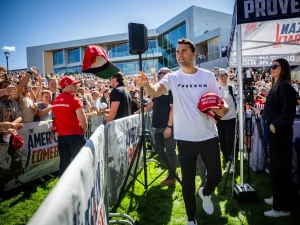Students learn about voter registration rights
February 22, 2020
The Cross-Cultural Center held the Politics and Voter Registration Rights discussion as a part of the Civility Dialogue series, a series by the Civility Campaign focused on bringing students together to peacefully discuss politics and political issues.
A small group of students was in attendance for discussion on Feb. 6.
“The whole idea is to find a place and a way that we can respect each other and talk about things that are difficult…you have to dig deep and find what you believe… your values and be open to facts but be open to the other ideas of the people around you,” said Mary Thompson, the civic engagement officer at the league of women voters and member of the San Diego Deliberation Network, who facilitated the discussion.
Before beginning the discussion, Thompson played a short two-and-a-half-minute CNN Politics video that went over the history of voting in the United States, mentioning the struggle that women and minorities had to go through in order to receive the right to vote.
After the video, Thompson told the students about the importance of California’s primary election day on March 3, otherwise known nationwide as Super Tuesday. Super Tuesday is when one third of the US population (15 states and certain US territories such as Guam) vote to decide which presidential candidate is going to represent each of the parties.
Any US citizens over the age of 18 are able to vote during Super Tuesday.
“You got to get registered and you need to act fast. You can register online. You don’t have to fill out a paper form, you can register online at sdvote.com. That’s actually the San Diego County Registrar of Voters,” said Thompson. “All you need to do when you go online is have your driver’s license number… [but] if you don’t have a driver’s license, you would have to have your official ID number, if you don’t have that you could have a social security number, but you have to have something to sort of verify who you are.”
The next step is for students to decide which political party they want to register with. According to Thompson, a third of the voters in California don’t identify with a political party and register as no-party preference.
There are some issues that come with registering as a no-party preference voter. If students register as no-party preference and receive the no-party preference ballot, they won’t see any of the presidential candidates on it.
This is “because the parties are going to decide who gets to see and vote for presidential candidates,” said Thompson.
Although, three of the political parties accept no-party preference voters as long as they apply for their ballot. These include the Libertarian Party, the American Independent Party and the Democratic Party.
Other parties such as the Green Party, Peace and Freedom Party and Republican Party, require voters to be registered for those parties in order to vote for those candidates.
“To vote for president, you basically have to choose which party you want to vote with and take action to make that happen,” said Thompson.
The ballot itself is not online but is either mail-in or filled out in person at a voting station. Mail-in ballots no longer require stamps and can simply be put in the mailbox. Though, in order to receive a mail-in ballot, voters must register by Feb. 25. If students want to vote on a ballot whose party they need to be registered with, they need to register with the party they want to vote for by Feb. 18.
Thompson also facilitated a discussion with attending students, asking if voting should or shouldn’t be open to non-citizens and if registering to vote should be automatic at birth.
All of the students agreed that non-citizens should be able to vote locally and statewide, but limit federal elections to citizens. The majority of the students also agreed that citizens should either be automatically registered to vote at birth or once they turn 18, to reduce the obstacle of registering to vote and increase voter turnout.
“I’ve taken away that voting should be more accessible or talked about and there are a lot of different opinions, but I feel like a lot of people kind of aligned the same way,” said Gianna Colosacco, a junior communication major.
Earlier in the discussion Thompson said, “Deciding who gets to vote is really what shapes our society; it shapes how diverse we are, it shapes how open we are or how secure we want to be.”
For further resources and to register to vote, check out https://www.sdvote.com/, https://votersedge.org/ca, https://lwvc.org/.






